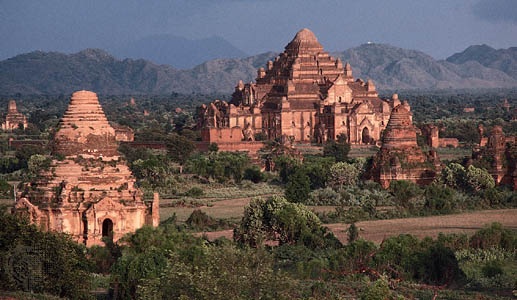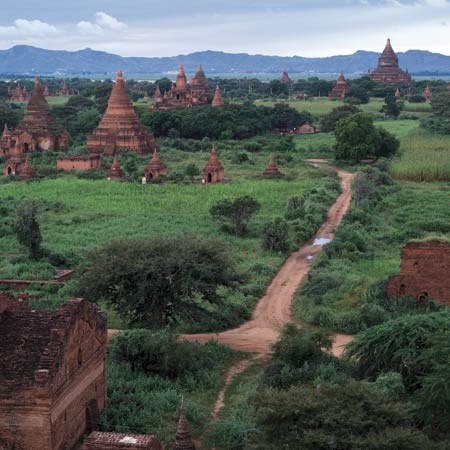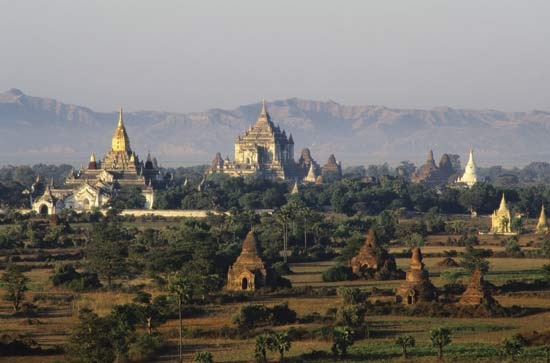Pagan
Myanmar
 village, central Myanmar (Burma), situated on the left bank of the Irrawaddy River and approximately 90 miles (145 km) southwest of Mandalay. The site of an old capital city of Myanmar, Pagan is a pilgrimage centre and contains ancient Buddhist shrines that have been restored and redecorated and are in current use. Ruins of other shrines and pagodas cover a wide area. An earthquake on July 8, 1975, severely damaged more than half of the important structures and irreparably destroyed many of them. The whole of the Buphaya pagoda, for nine centuries a landmark for riverboatmen, tumbled into the Irrawaddy and was carried off by the waters. The village also has a school for lacquer ware, for which the region is noted.
village, central Myanmar (Burma), situated on the left bank of the Irrawaddy River and approximately 90 miles (145 km) southwest of Mandalay. The site of an old capital city of Myanmar, Pagan is a pilgrimage centre and contains ancient Buddhist shrines that have been restored and redecorated and are in current use. Ruins of other shrines and pagodas cover a wide area. An earthquake on July 8, 1975, severely damaged more than half of the important structures and irreparably destroyed many of them. The whole of the Buphaya pagoda, for nine centuries a landmark for riverboatmen, tumbled into the Irrawaddy and was carried off by the waters. The village also has a school for lacquer ware, for which the region is noted.Pagan's importance lies in its heritage rather than its present. It was first built probably in AD 849 and, from the 11th century to the end of the 13th, was the capital of a region roughly the size of modern Myanmar. In 1287 it was overrun by the Mongols during their wide-ranging conquests, and it never recovered its position, though a little desultory building continued on Buddhist shrines.
Old Pagan was a walled city, its western flank resting on the Irrawaddy River. It was the focus of a network of highroads by means of which its rulers could command a large region of fertile plains and could dominate other major Myanmar dynastic cities, such as Pegu. From the port of Thiripyissaya, further down the river, important overseas trade was conducted with India, Ceylon, and other regions of Southeast Asia. The walls of the old city, within which lies a substantial area of the modern town, probably originally contained only royal, aristocratic, religious, and administrative buildings. The populace is thought to have lived outside in homes of light construction closely resembling those occupied by the present-day inhabitants. The walled city, whose moats were fed by the Irrawaddy, was thus a sacred dynastic fortress. The circuit of its walls and river frontage is some 2.5 miles (4 km), and there is evidence that perhaps as much as a third of the old city has been washed away by the river. Because building was principally in brick, decoration was carried out in carved brick, in stucco, and in terra-cotta. The earliest surviving structure is probably the 10th-century Nat Hlaung Gyaung. The shrines that stand by the Sarabha Gate in the eastern wall, although later than the wall they adjoin, are also early. These are shrines of protecting nats—the traditional spirit deities of the animist ethnic Burmans.
Between about 500 and 950, people of the Burman ethnic group had been infiltrating from the north into a region occupied by other peoples; these people already had been converted to Indian religion, especially the Mahāyāna Buddhism of Bihār and Bengal. Under King Anawrahta (reigned 1044–77), the ethnic Burmans finally conquered the other peoples of the region, including a people called the Mon, who were previously dominant in the south. They transported the Mon royal family and their scholars and craftsmen to Pagan, making it the capital and centre of an official, fundamentalist form of Hīnayāna (Theravāda) Buddhism adopted from Ceylon (Sri Lanka), about 1056. This initiated the period of Pagan's greatness, which was sustained at first by Mon artistic traditions. The enormous number of monasteries and shrines built and maintained during the next 200 years was made possible both by the great wealth of the royal exchequer and by the large number of slaves, skilled and unskilled, whose working lives were dedicated to the support of each institution. The city became one of the most important centres of Buddhist learning.

 Lesser buildings are grouped around the more important pagodas and temples. Scattered around these are smaller pagodas and buildings, some of which may once have been aristocratic palaces and pavilions later adapted to monastic uses—e.g., as libraries and preaching halls. All are based on Indian prototypes, modified during subsequent development by the Mon. The principal architectural theme is the Buddhist stupa, a tall bell dome, designed originally to contain near its apex the sacred relics of Buddhist saints. Another is the high, terraced plinth, which may be supplemented by stairs, gateways, extra stupas, and pinnacles and symbolizes a sacred mountain. During the course of artistic evolution the themes were frequently combined, and the combination opened into a complex rectangular hall with porticos extended from the sides, crowned by a stupa or, in some cases, by a rectangular tower of curved outline reminiscent of the contemporary Indian Hindu shrine tower. Interior arches and vaults, both rounded and pointed, are, however, constructed by a true radiating-arch technique that was not used in India. A vista across the site of Pagan shows a series of variations and combinations of the themes. Many buildings, especially those no longer in use and hence unrestored, bear substantial remains of external, decorative stucco and terra-cotta (adding flamboyance to the finely proportioned rectilinear structures) and internal paintings and terra-cottas recording Buddhist legend and history.
Lesser buildings are grouped around the more important pagodas and temples. Scattered around these are smaller pagodas and buildings, some of which may once have been aristocratic palaces and pavilions later adapted to monastic uses—e.g., as libraries and preaching halls. All are based on Indian prototypes, modified during subsequent development by the Mon. The principal architectural theme is the Buddhist stupa, a tall bell dome, designed originally to contain near its apex the sacred relics of Buddhist saints. Another is the high, terraced plinth, which may be supplemented by stairs, gateways, extra stupas, and pinnacles and symbolizes a sacred mountain. During the course of artistic evolution the themes were frequently combined, and the combination opened into a complex rectangular hall with porticos extended from the sides, crowned by a stupa or, in some cases, by a rectangular tower of curved outline reminiscent of the contemporary Indian Hindu shrine tower. Interior arches and vaults, both rounded and pointed, are, however, constructed by a true radiating-arch technique that was not used in India. A vista across the site of Pagan shows a series of variations and combinations of the themes. Many buildings, especially those no longer in use and hence unrestored, bear substantial remains of external, decorative stucco and terra-cotta (adding flamboyance to the finely proportioned rectilinear structures) and internal paintings and terra-cottas recording Buddhist legend and history. Anawrahta constructed the Shwezigon pagoda. Nearby he built a nat shrine with images. The Shwezigon is a huge, terraced pyramid, square below, circular above, crowned by a bell-shaped stupa of traditional Mon shape and adorned with stairways, gates, and decorative spires. It is much revered and famous for its huge golden umbrella finial encrusted with jewels. It was considerably damaged in the earthquake of 1975. Also revered are the late 12th-century pyramidal Mahābodhi, built as a copy of the temple at the site of the Buddha's enlightenment at Bodh Gayā, in India, and the Ananda Temple just beyond the east gate, founded in 1091 under King Kyanzittha. By the time the Thatpyinnyu Temple was built (1144), Mon influence was waning, and a Burman architecture had evolved. Its four stories, resembling a two-staged pyramid, and its orientation are new. Its interior rooms are spacious halls, rather than sparsely lit openings within a mountain mass, as in the earlier style. This building combined the functions of stupa, temple, and monastery. The Burman style was further developed in the great Sulamani Temple and culminated in the Gawdawpalin, dedicated to the ancestral spirits of the dynasty (late 12th century), whose exterior is decorated with miniature pagodas, the interior with extremely lavish, coloured surface ornament.
Anawrahta constructed the Shwezigon pagoda. Nearby he built a nat shrine with images. The Shwezigon is a huge, terraced pyramid, square below, circular above, crowned by a bell-shaped stupa of traditional Mon shape and adorned with stairways, gates, and decorative spires. It is much revered and famous for its huge golden umbrella finial encrusted with jewels. It was considerably damaged in the earthquake of 1975. Also revered are the late 12th-century pyramidal Mahābodhi, built as a copy of the temple at the site of the Buddha's enlightenment at Bodh Gayā, in India, and the Ananda Temple just beyond the east gate, founded in 1091 under King Kyanzittha. By the time the Thatpyinnyu Temple was built (1144), Mon influence was waning, and a Burman architecture had evolved. Its four stories, resembling a two-staged pyramid, and its orientation are new. Its interior rooms are spacious halls, rather than sparsely lit openings within a mountain mass, as in the earlier style. This building combined the functions of stupa, temple, and monastery. The Burman style was further developed in the great Sulamani Temple and culminated in the Gawdawpalin, dedicated to the ancestral spirits of the dynasty (late 12th century), whose exterior is decorated with miniature pagodas, the interior with extremely lavish, coloured surface ornament.Additional Reading
G.H. Luce, Old Burma—Early Pagan, 3 vol. (1969–70); Michael Anng-Thwin, Pagan: The Origins of Modern Burma (1985); Paul Strachan, Imperial Pagan: Art and Architecture of Burma (1990).
king of Myanmar
died 1880, Mandalay, Burma 【Myanmar】
king of Myanmar (1846–53), who suffered defeat in the Second Anglo-Burmese War (Anglo-Burmese Wars), after which Yangon (Rangoon), the province of Pegu, and other areas in southern Myanmar were annexed by the British (British Empire) and became what was called Lower Burma.
Pagan deposed his father, the insane king Tharrawaddy, in 1846. Although Pagan acted with tact and restraint during the crisis preceding the war, part of his undoing was the aggressive policy of Lord Dalhousie (Dalhousie, James Andrew Broun Ramsay, Marquess and 10th Earl of), the governor-general of India, who declared that “of all the Eastern nations with which the Government of India has had to do, the Burmese were the most arrogant and overbearing.”
In 1851 Pagan's governor in Yangon, Maung Ok, charged the captains of two British merchant ships with murder, embezzlement, and evading customs fees. They were forced to pay several hundred rupees before being allowed to return to Calcutta, where they demanded compensation from the Myanmar government. Dalhousie sent an emissary with a letter to the king requesting compensation that amounted to £920 and the dismissal of Maung Ok. Pagan agreed to replace Maung Ok, but the emissary's lack of tact and violation of his instructions made it impossible for the new governor to deal with him. On January 6, 1852, the British were evacuated and the harbour blockaded. Three days later British warships began firing on the city.
On February 7, 1852, Pagan wrote Dalhousie, protesting the acts of aggression in Yangon and expressing hope that the governor-general would repudiate them. A few days before, the governor of Yangon had offered to pay the compensation for the two ship captains. On February 13, however, Dalhousie sent an ultimatum to the king, demanding an indemnity equivalent to £100,000. Pagan did not answer the ultimatum, which expired on April 1, and a few days later British troops entered Myanmar territory. Yangon was taken and, by December 1852, Lower Burma was occupied. On February 18, 1853, Pagan was deposed by his brother, Mindon, who favoured reconciliation with the British.
- Scherrer, Paul
- scherzo
- Scheveningen
- Schiaparelli, Elsa
- Schiaparelli, Giovanni Virginio
- Schickele, René
- Schiedam
- Schiele, Egon
- Schiess, Betty Bone
- Schiff, Dorothy
- Schiff, Jacob H
- Schiff, Moritz
- Schikaneder, Emanuel
- Schildkraut, Joseph
- Schiller, Friedrich von
- Schilling, Curt
- Schiltberger, Johann
- Schimmelpenninck, Rutger Jan
- Schimper, Andreas Franz Wilhelm
- Schindewolf, Otto Heinrich
- Schiner, Matthäus
- Schinkel, Karl Friedrich
- Schio
- schipperke
- Schirach, Baldur von